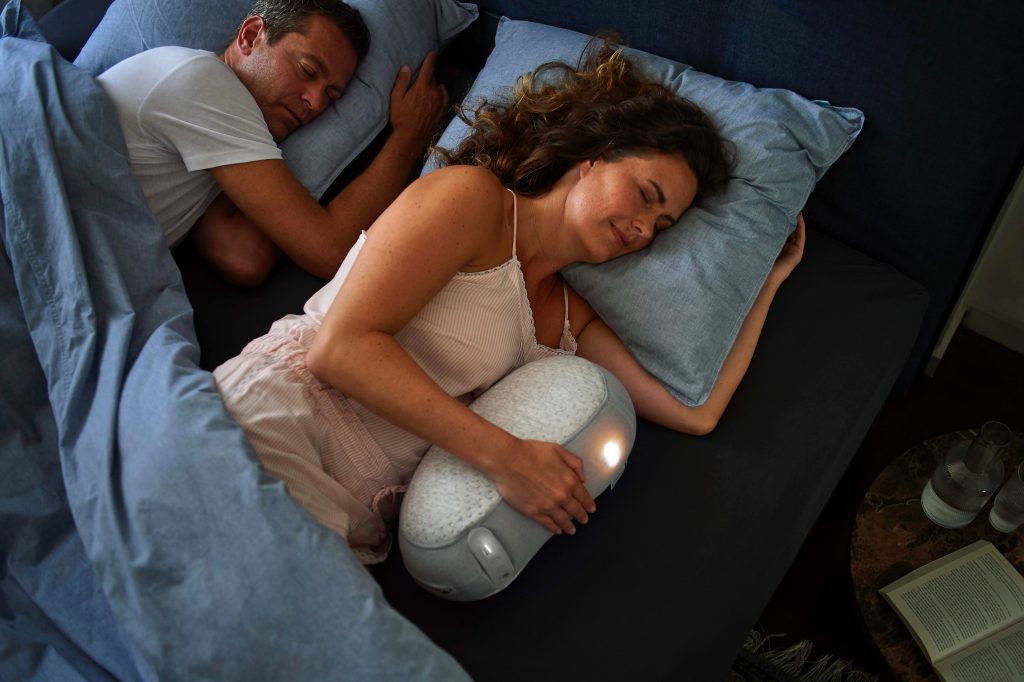Your lower back has two essential jobs: supporting the majority of your body’s weight and allowing your body to sit, stand, walk, and even lie down. This is why it’s so important to protect your lower back when sleeping with back pain. In addition to this, sleep and back pain are strongly connected, so protecting your spine during the night is especially important.
Back pain can disturb or even prevent you from sleeping, and poor sleep can make your pain feel worse. On top of this, sleeping in a position that puts your spine out of alignment, on a mattress that doesn’t properly support your spine, or even with the wrong pillow may also make your pain worse.
While protecting your spine while you sleep might not seem possible, there are steps you can take to make sure your back is protected.
Mattress Firmness
If you’re sleeping with back pain, the first thing you need to do to ensure that you’re protecting your spine while sleeping is to get the right mattress.

You may not realize it, but if you’ve been experiencing back pain, your mattress may be the cause. Your spine needs to be properly supported during the 6-8 hours that you spend sleeping every night and this requires a mattress that doesn’t sag. In fact, 63% of people sleeping with back pain who switched to a firmer mattress reported improvement in their pain.
Generally, experts recommend sticking with a medium-firm mattress in order to prevent or reduce your back pain. However, everyone’s body is different so in order to truly make sure that you’ve chosen the best firmness for your needs, you’ll need to take your weight, body shape, sleeping position, and personal preference into consideration as well.
Some mattress stores will allow you to test your mattress for a certain period of time, so if you’re shopping, look for a store that will allow you to do this so you can make sure that the mattress you’ve chosen is the best one for your body. If buying a new mattress isn’t a realistic option for you at the moment, placing plywood supports under your mattress could help add some firmness as well.
Sleeping Posture
Tip number two for sleeping with back pain is to make sure your sleeping posture is good for your spine. You probably know your posture when you’re sitting or standing is important in preventing back pain and your sleeping posture is no different, whether you’re sleeping with back pain or not.

Your sleeping position affects the alignment of your spine, which can either exacerbate or reduce your back pain. Some sleeping positions are worse than others, but any position that involves twisting or putting any kind of pressure on your spine will likely increase or cause pain, as these positions are particularly detrimental to your spinal discs.
Sleeping on your side with a partial bend in your knees is considered the best position to sleep in to avoid back pain. This position balances your body, reducing the pressure placed on your spine, especially your lumbar spine. This is important because your lumbar spine supports most of your weight and these spinal discs are the most easily damaged.
However, if you’re used to a specific position, you may have trouble sleeping in a different one, so there are some things you can do to make sleeping in any position easier on your spine.
Stomach
First, you should know that this position is the hardest on your back and most likely to make sleep harder for anyone sleeping with back pain. It is possible to reduce the strain on your back, however, by placing a pillow under your pelvis and lower abdomen. You may also want to consider sleeping without a pillow under your head if you feel a significant strain on your back.
Side
As mentioned, sleeping on your side is the best position for anyone sleeping with back pain to reduce or prevent pain. Of course, this may not be the most comfortable position for everyone, so it may help to put a pillow between your legs, which should be slightly bent at the knees. You can also try sleeping with a body pillow for added comfort.
Back
Sleeping on your back, while not the optimal position if you’re sleeping with back pain, will still reduce the strain placed on your spine. You can further support your spine and keep it in it’s natural alignment by placing a pillow under your knees and another small pillow or rolled towel under the small of your back.
Pillow
The right pillow may also be able to make sleeping with back pain easier on your spine. A contoured pillow is considered the best way to reduce the strain on your cervical spine. A contoured pillow will cradle your head and neck while providing support for your upper spine, making it the best option for anyone sleeping with back pain.

You may also want to consider a memory foam pillow, which will contour specifically to your neck. A water pillow may also be a good option for you, providing firm, all-over support for your head and neck.
Whether you’re sleeping with back pain or not, you should also avoid placing a pillow under your shoulders. This will throw off the alignment of your spine, worsening your pain.
Depending on the position you sleep in, there are also different pillow recommendations you’ll want to follow to provide your back with as much support as possible.
Stomach
When sleeping on your stomach, it’s best to use a pillow that’s as thin as possible, or even no pillow at all, as mentioned above. If you’d like to try getting out of the habit of sleeping in this position, it may also be beneficial to try sleeping on your side with a body pillow. This will give you the feeling of support on your stomach while avoiding the strain that this position can place on your spine.
Side
When sleeping on your side, a thick and firm pillow is recommended, as this will better align your head and cervical spine with the rest of your body. A pillow with an extra-wide gusset (the side panel that gives structure and form to a pillow) is even better. This will provide support for the space between your ear and shoulder. The pillow placed between your knees in this position should also be firm.
Back
If sleeping on your back is the most comfortable position for you, your pillow should fill the entire space between your neck and your mattress. You may also want to look for thin pillows, which will keep your head and cervical spine in line with the rest of your body.
Other Tips for Making Sleeping With Back Pain Easier
Here are some other general tips that will likely make sleeping with back pain a more restful experience.
Working out regularly is known to help people get a better night of sleep. It makes sure you’re expending your energy so that by the time you should get to bed, you’ll actually be ready to get some rest. In addition to this, focusing on strengthening your core during your workouts may reduce your risk of nightly muscle spasms or back strain.

Even something as small as how you get in and out of bed can cause back pain. Paying attention to how you get out of bed so that you can avoid sudden, jerky movements or bending forward from your waist will help prevent hurting your back. It’s best to roll over onto your side then push yourself up using your hands and while swinging your legs over the side of your bed.
You should also avoid alcohol and caffeine, especially when it’s close to the time you go to bed. Alcohol can affect the quality of your sleep and caffeine is a stimulant, so you’ll likely have trouble falling and staying asleep after consuming caffeine.
Finding relaxation techniques that work to help you feel sleepy will also making sleeping with back pain easier by getting your body ready for rest.
It’s also important to reduce anything that may potentially disrupt your sleep. Waking up in the middle of the night for whatever reason is always troublesome, but waking up while sleeping with back pain is worse. Once you wake up, your pain may not let you fall asleep again, so try wearing earplugs to reduce noise or wear a sleeping mask so that light won’t disturb you. Anything you can do to make yourself more comfortable at night will only help you get a better night’s sleep.
The Discseel® Procedure
If you’re sleeping with back pain and still don’t feel relief after following these tips, your pain may be caused by annular tears.
Fortunately, the Discseel® Procedure is a non-surgical, minimally invasive treatment known to be able to both seal and heal annular tears, the cause of most back pain, preventing further leaking and providing long-term relief. Using Fibrin, an FDA-approved substance that is used off-label in this procedure, which is known to encourage tissue growth in other parts of the body, the Discseel® Procedure allows torn spinal disc tissue to regrow and heal itself.
If you’re ready to get lasting relief from your back or neck pain with a treatment that won’t limit your mobility, apply for the Discseel® Procedure today and find out if you’re a candidate.


